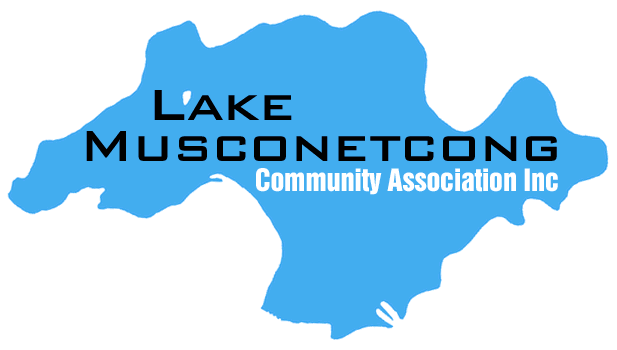2009 Water Chestnut Plague on Lake Musconetcong
Click here to ask how you can prevent this from happening again.
Water Chestnut Plants, Trapa natans..perhaps the biggest threat to Lake Musconetcong. (And no, we can’t eat them!)

YES INDEED..this is OUR lake circa 2009 at the height of our water chestnut invasion. Within a few short years, this invasive plant expanded from a few sightings to almost 100 acres, covering almost one third of our lake.
If aggressive action hadn’t been taken at that time, water chestnuts would likely have blanketed our entire lake within two years or so.
The Lake Musconetcong Regional Planning Board launched an intense but responsible program of herbicide remediation and daily weed harvesting with the aid of volunteers including members of the Lake Musconetcong Community Association. Since then, the water chestnut population has been dramatically reduced, contained to about ten to fifteen acres a year, primarily in four particular locations on the lake. The LMCA and the LMRPB continue efforts to completely eradicate this most harmful plant. Harvesting and herbicide treatment is still employed, and we have a team of LMCA members, our water scouts, who go out together several times a season to handpull these plants while they are tender and easy to pull up seed and all, and importantly, before they drop new seeds to the lake bed. LMRPB volunteers accompany us with the weed harvesting machine, a floating barge that provides us convenient disposal of our harvested plants. Volunteers also offer to “Adopt A Shoreline”, regularly scouring their assigned areas for these plants. Email us at info@lmcanj.org to find out how to join this important, and actually, enjoyable program.



Water Chestnut:
European water chestnut (Trapa natans), an invasive aquatic plant inadvertently released into waters of the Northeast by water gardeners in the mid 1800s. They are spreading throughout New England and the Mid-Atlantic States, clogging waterways, lakes, and ponds and altering aquatic habitats at exponential rates. This is a very aggressive plant that shades and competes with more desirable species. The plant impacts boating and fishing, and the spiked seeds can wash up on beaches having a substantial negative impact on recreational use. Water chestnut prefers shallow, nutrient-rich lakes and rivers.
DESCRIPTION: Usually rooted in the mud, this aquatic plant has a rosette of floating leaves, 1/2 to 1 inch long, at the tip of a submersed stem, which can reach over 15 feet in length. The flowers of this species have four white petals about 1/3 of an inch long. The fruit is a black, four-horned nut-like structure that is about an inch wide and weighs approximately 6 grams. The spiked seed is of little value as food for wildfowl.
LIFE CYCLE BIOLOGY: Within the United States, this species is an annual that can reproduce both by vegetative means and seed production. Each flower is bisexual and once the insect-pollinated flowers are fertilized the flower stalks curve downward with the result being the fruit develops underwater. Fruit fall to the floor of the water body over winter and seeds germinate in the spring. One acre of water chestnut can produce enough seeds to cover 100 acres the following year. Each seed can give rise to 10-15 rosettes and each rosette can produce as many as 15 seeds. Seeds can remain viable for up to 12 years.
DISPERSAL/SPREAD: The fruit of water chestnut may be dispersed when individual plants are uprooted and float downstream. These plants can also be dispersed by fragmentation. Due to the large size and weight of the sinking seeds, it is unlikely that waterfowl or water currents can transport seeds to any great extent.
RISKS/IMPACTS: Because of their ability to reproduce rapidly forming extensive floating mats, this species has become a nuisance in the United States, hindering navigation of waters and inhibiting the growth of native aquatic plant species. The hard spines on the fruit can impact swimming. Decomposition of this abundant plant species can also lead to lower oxygen levels in the water.
MANAGEMENT/PREVENTION: Mechanical control by repetitive harvesting of this species does reduce the amount of new seeds dropping to waterbeds. Herbicidal treatment is effective, especially before plants have had a chance to mature for the season. Hand pulling before areas become inundated is very effective, especially when plants are young, and if an area can be tended to thoroughly and often by a dedicated and large enough team. Attempts to control water chestnut with the aid of biological insects have been tried with no measurable success.
The best means of control is prevention. Like all invasive species, the key to preventing their spread is knowledge. You can help by practicing a few good techniques to stop the spread of any aquatic invasive plant.
1) Learn to correctly identify water chestnut and other invasive aquatic plants.
2) Rinse any mud and/or debris from equipment and wading gear and drain any water from boats before leaving drainage areas.
3) Remove plant fragments from all equipment. The transportation of plant fragments on boats, trailers and in live wells is the main route of introduction to new lakes and rivers.
It’s much better but not over.
Below are Water Chestnuts in Byram Bay, Lake Musconetcong 2018


